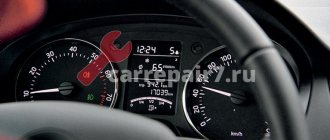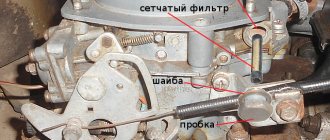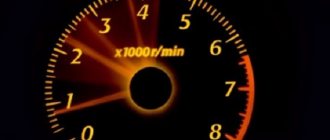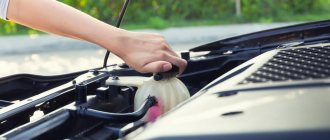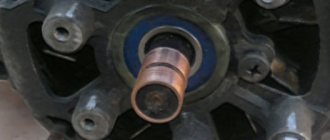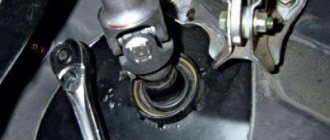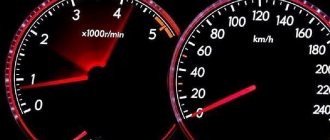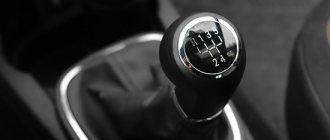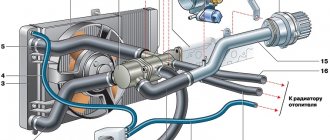From time to time, every car owner is faced with a situation where the vehicle begins to jerk when starting to move when pressing the gas pedal or driving at low speeds. This behavior of the car is often caused by not too serious disturbances in the operation of the internal combustion engine and other systems. However, they need to be diagnosed and eliminated as soon as possible. Otherwise, they can lead to a complex breakdown, which will take a lot of time and money to fix.
When can a car “jerking” appear and what are the causes of the phenomenon?
In the vast majority of cases, the symptom of unstable driving can be diagnosed in the following situations:
• While the vehicle is starting to move (pushing away).
• During slow driving at low engine speeds.
• If necessary, accelerate suddenly while driving on the road.
• While the power unit is operating at high speeds.
In addition, the described behavior of the vehicle may also occur in other operating modes. The reason for this may be malfunctions of the following systems and components of the machine:
1. System for supplying the fuel mixture to the combustion chamber.
2. Ignition system.
3. Incorrect operation of the transmission.
4. Malfunctions in the operation of the car's electronic engine control unit.
How to troubleshoot?
Let's take a closer look at the main and auxiliary systems of the car, which can cause the vehicle to “jerk” while driving. We will also focus on how to eliminate diagnosed problems.
Fuel mixture supply system
Quite often, the cause of unusual behavior of a car while driving is improper operation of the fuel supply system to the engine or the injection system of the air-fuel mixture into the combustion chamber. In other words, the internal combustion engine cannot obtain the required amount of gasoline or diesel fuel. As a result, there is not enough torque from the shaft to transfer mechanical force to the suspension, and you end up with a dip in power.
To get rid of troubles, you need to:
• Check the operation of the throttle assembly.
• Test the functionality of the idle speed sensors.
• Check the correct position of the throttle valves.
• Check the functionality of the mass air flow sensor.
In most cases, the defect is found in the injectors, which are responsible for injecting the fuel mixture. Less commonly, an uneven ride is associated with the air passages that connect the injector and the air filter. Depressurization is possible, which leads to loss of pressure.
The problem found can be corrected by replacing damaged parts. You can do this yourself, but it is better to seek help from service center specialists. After carrying out the work, it is important to additionally check the tightness of connections along all fuel and air supply lines.
If your car is equipped with a carburetor, you need to check the idle air valve and also make sure that the body of the device itself does not contain cracks, chips or other defects.
Ignition system
The next most common cause of a car “jerking” is a breakdown in the ignition system. This leads to the fact that the fuel mixture in the cylinders ignites at the wrong time. In addition, this may also occur due to the fact that low voltage current is supplied to the spark plugs. And the resulting spark is not enough for ignition to occur.
To diagnose faults you should check:
• Serviceability of spark plugs installed in the engine.
• Integrity of high-voltage wires going to the spark plugs.
• The performance of sensors that monitor the position of the camshaft and crankshaft.
Often, the car may jerk due to physical wear of the spark plugs or because the spark plug gap does not meet the required parameters.
Transmission
“Jerking” of the car can also occur due to the fact that the transmission elements are not operated in accordance with the technical regulations. This happens, for example, if the transmission fluid in the gearbox (especially automatic) has not been changed. And when the car’s mileage is 150-200 thousand km, it is necessary to repair the automatic transmission, otherwise the car will drive with slight jolts all the time.
It is better to carry out maintenance of such a complex unit as a gearbox only in a specialized center. You can take on work yourself only if you know exactly what needs to be done and how.
Self-check of the car, identification of symptoms
To understand the possible cause of the breakdown, you should clearly identify the symptoms, and based on this, draw some conclusions.
When the car is warmed up to operating temperature, when you press the gas pedal, it begins to “stupid” or twitch slightly, and then when you pick up speed, this problem disappears and the car operates normally.
If this problem occurs only during acceleration, and not, for example, when starting from a standstill, then the reasons will be the same. If the car jerks when starting from a standstill, then this may be a problem with the clutch or basket. If vibration is felt while driving and not only during acceleration, this may indicate a failure of the cushions securing the engine.
Additionally, we recommend reading our expert’s article, which talks about what vibration when braking means.
You can learn how to replace a timing belt with your own hands from our specialist’s detailed material.
Knocks in the engine
It also happens that the engine begins to make abnormal sounds that were not previously characteristic of it. And, with an increase in engine speed, the sounds only intensify.
Crankshaft pulley
Most often, we are talking about vibrations of the crankshaft pulley. In this case, you will have to replace it with a new one, since it cannot be repaired. You can also highlight the loosening of the timing belt. To remove this effect, it will be enough to adjust the tension through a specialized service technician.
Flywheel loosening
It may also be that the flywheel is loose. This doesn't happen often, but it's worth checking just in case.
In addition to the above reasons, wear of the CPG may occur. You need to check the pistons, bearings and the crankshaft itself to see if they are worn out. If this is the case, then it is worth replacing these parts with new ones. The specified knock is characterized by muffledness, and it is heard mainly at low crankshaft speeds.
If we talk about vibration in the engine, then it occurs after repair work, when the weight distribution of the CPG was carried out incorrectly. In this case, you will have to independently balance the parts according to their weight.
In addition, a situation with different compression across the cylinders is possible, which happens when the CPG is exhausted or there are problems with the valves.
Causes of jerking during acceleration
There can be several reasons why a car jerks during acceleration.
Malfunctions in the engine ignition system
If the ignition fails, it will be strongly felt during acceleration. This happens because when you press the gas pedal, fuel is injected into the cylinders, and detonation should occur there. If the ignition is set incorrectly or fails, then fuel flows, but the spark strikes at the wrong time. In other words, some part of the fuel does not ignite or ignites at the wrong time. Some cylinders may not detonate at all. This all leads to unbalanced work and, consequently, jerks. The cause could also be faulty spark plugs or armor wires. It is advisable to change spark plugs sometimes. Spark plugs are checked using special equipment, where, at a pressure the same as in the engine, it is checked whether the spark plug produces a spark.
Armor wires are checked with an ohmmeter for the presence of the required resistance. You can also check the quality of the connections between the wires and the spark plugs. The procedure should be carried out with a warm engine. You should take water into a bottle and use a sprayer to distribute it with the engine running on the armored wires and the connection with the spark plugs. If the engine speed begins to decrease and the car starts to stall, then the wires should be replaced.
If you do not understand how the ignition is set, it is better to contact a specialist. This process is quite accurate, there are no mistakes to be made there.
Malfunctions in the power system
The most common reason for a car jerking during acceleration is a problem with the power and fuel supply system. When you press the gas pedal due to contaminated elements of the fuel system, there is not enough fuel to accelerate. This is why jerks occur during acceleration.
The problem may be:
- Filters. The air filter and fuel filter need to be changed regularly. This is a consumable item that quickly breaks down.
- Contamination of the fuel supply system. In carburetor cars, these are jets in which the slightest dust or pieces of dirt greatly affect the flow of fuel. Injector nozzles may become clogged.
- Fuel pump. If it fails or partially begins to show less performance, namely, does not have time to pump the required fuel pressure into the system, then during acceleration this deficit will be visible.
There are various aerosols and additives for cleaning fuel systems. If you choose a product from a trusted manufacturer, they work very well. But this may not be enough in all cases. There are cases where mechanical cleaning or repair of individual parts is required. A valve or some other part of the mechanism may fail.
And help me, please
Complete frequently asked questions for the site, for a section colloquially called FAQ or FAQ. What questions do you have? What's not clear?
Here are, for now, the most frequently asked questions, the answers to which are on the website:
- I have my own spare parts. Can you do some repairs?
— Is it possible to call your specialist “at home” or is it necessary to come to your auto repair center?
— I called you yesterday, and you named the price “From so many rubles.” Is it really difficult to name the exact amount?
— You have photos of certificates posted on your website. What does this mean – “certified auto repair shop”?
— How is the problem solved if the client is not satisfied with the quality of the work performed?
— Many car owners are chasing after original auto parts. Is there a technical difference between original and non-original and what do you use?
— What can your auto repair center recommend if a buyer decides to buy any of the used models?
- Tell me, I have a question about computer diagnostics of the engine - if you cannot find the cause of the car malfunction, no payment will be made for the service provided?
— When asked about the causes of the malfunction, I received a clear answer: replacement of the high-pressure hose. How can you make a diagnosis of a malfunction over the phone? Is this professionalism or p...?
— Is it possible to order original spare parts from you?
Resolving identified problems
Once the cause has been identified, you can begin to eliminate it. In most cases, this work should be entrusted to specialists. After all, the reasons that at first glance were key are not always exactly what they are. Correct ignition tuning, carburetor adjustment, injector adjustment is something that is best entrusted to a knowledgeable person. If it was determined that the jerking was caused by dirty filters, then you can use an aerosol cleaner. It is sprayed into the air filter hole. Fuel tank additives also perform quite well. These additives clean the fuel line pipes and all other elements. XADO additives have proven themselves well.
Other section materials
| The engine does not develop full power |
| Popping sounds in the intake pipe |
| Silenced shots |
| Increased fuel consumption |
| Increased oil consumption |
| Engine knock |
| The engine gets very hot |
| The electric fan of the engine cooling system is constantly running |
| The engine takes a long time to warm up to operating temperature |
| Drop in coolant level in the expansion tank |
| Extraneous noises and knocks in the engine |
| Strong engine vibration |
| Increased content of harmful substances in exhaust gases |
| The "Check" engine management system malfunction indicator lights up when the engine is running. |
| Engine compression test |
| Checking the ignition coil and its circuits |
| Insufficient oil pressure |
| Checking high voltage wires |
| Checking the pressure in the engine power supply system |
| The clutch is slipping |
| Clutch leads |
| Jerking when starting off |
| Rattling, knocking noise when engaging clutch |
| Increased noise when engaging the clutch |
| Gearbox noise |
| Gears are difficult to engage |
| Gears turn on spontaneously |
| Noise, crackling, squealing of gears when the gear is engaged |
| Final drive noise |
| Oil leak |
| Knock when starting |
| Noise when driving on a smooth highway |
| Knock when driving over bumps |
| Knocking, squeaking noises when the suspension operates |
| There are traces of shock-absorbing fluid on the telescopic strut |
| There are traces of grease on the drive joint cover (shaft) |
| Knocking, clicking noises when turning |
| Vibration when driving |
| Deviation from straight-line motion |
| Rapid tire tread wear |
| Uneven tire tread wear |
| Increased free play of the steering wheel |
| The steering wheel turns hard |
| Creaking, squealing when braking |
| Vibration when braking |
| Pull or skid when braking |
| Increased brake pedal travel |
| The brake pedal travel is normal, but the car does not brake well. |
| Incomplete release of all wheels |
| Braking one of the wheels |
External and internal CV joints
If some suspension parts are poorly secured, then when driving (especially during a sharp start), they can cause the car to jerk. First of all, you need to check the inner and outer CV joints. The inner CV joint transmits rotational energy from the gearbox to the axle shafts and then to the wheels. This element is quite important, and if problems arise with it, it must be changed. This can be done at any service station. Features of failure of the inner CV joint are as follows:
- When destroyed, the inner CV joint becomes loose and can turn when transmitting forces, especially at the start.
- On a straight road without the smallest potholes, the inner CV joint can knock. In this case, it will seem that a dull knock is coming from the wheels.
- Outer CV joints may crunch when turning. If destroyed, they can also cause the car to jerk when starting off.
- Usually, internal CV joints simply wear out and because of this they fail. However, rarely the gearbox can cause a breakdown of this unit. This happens in cases where there is something wrong with the box itself.
- Outer CV joints can break due to impacts or careless driving on a bad road.
If your VAZ car jerks when starting from a stop, then first of all you need to check the CV joints. Often on forums when discussing a similar problem, users point to this particular node. Considering the prevalence of these cars and the cheapness of spare parts, repairing this element is unlikely to be expensive. It is worth noting that a similar problem occurs on the VAZ-2114 car. When starting off, the car jerks, but after replacing the CV joint (“grenade”), the problem disappears.
You will be very lucky if the problem turns out to be in the car's CV joints. These are inexpensive items that are easy to replace. It is much worse if a fault is discovered in the gearbox.
Riding style
Speaking about why the car jerks when starting from a stop, we need to start with the obvious. The very first and most obvious reason is a harsh clutch. If you start, add gas and suddenly release the clutch pedal, the car will definitely jerk. Therefore, first of all, you need to try to change your driving style. At a minimum, when starting off, you need to release the clutch pedal very slowly and add a little more gas. However, you shouldn't press the gas pedal too hard.
However, if with an automatic transmission the car jerks when starting, then you won’t be able to change your driving style here, because there is simply no clutch pedal. But even with a manual transmission, the problem may be different. If the car still jerks even when starting smoothly, the problem is clearly not a sudden grip of the clutch discs.
This is interesting: Car tire markings (decoding) Lada Granta
Steering gear
If the steering mechanism is faulty, a similar problem can also occur. If the steering rack has any malfunction, it can create jerks when starting. In this case, the worn parts of the rack are simply replaced, and the problem disappears.
Also, the steering rack tips may have strong play. As a result, during a sharp start or braking, or increase in speed, so-called steering wheel wobble may occur. Bent tie rods result in a sharp jerk of the steering wheel to one side when starting off. This problem requires a quick solution.
Other elements of the steering system, including bushings and silent blocks, can cause the car to knock and jerk when driving. All this applies to the steering mechanism - it can be the reason why, for example, a GAZelle car jerks when starting off. But GAZelle is not the only brand where such breakdowns occur.
Note that problems with the steering mechanism are easier to solve than problems with the automatic transmission. However, the steering mechanism requires urgent repair for the safety of the driver and passengers.
Information letter No. 5-17 dated 01/23/17
When owners of LADA cars of the KALINA, GRANTA, PRIORA, VESTA families, equipped with a 1.6 liter engine and gearboxes 2180/2181/2182, complain about “Vibrations, jerking when starting the car,” carry out diagnostics according to the attached methodology, Appendix 1.
If you need to replace the clutch kit:
- If the vehicle is equipped with clutch driven disc 21703-1601130-30, in the absence of violation of operating rules, replace the clutch kit under warranty with: pressure plate 21703-1601085-30, driven disc 21703-1601130-31;
- If the vehicle is equipped with a driven clutch disc 21703-1601130-31 (standard installed only on LADA VESTA GFL120 (KP 21827) vehicles) or a driven clutch disc 21703-1601130-32 (standard installed only on LADA VESTA vehicles GFL110 (KP 21807)) it is necessary to draw up a CLO with a description of the work performed and act in accordance with the recommendations received in response to the CLO.
Fill out an AGO for the work carried out with a description of the reasons for the non-compliance and using the defect code, 1601130-051-001 “Vibration, jerking when starting a car with AMT”, with an attachment of a photo of the error codes or 0 “Vibration of the car when starting off”, depending on vehicle configuration, defective part 1601130, labor intensity position in accordance with the current collection of labor intensity.
How to prevent this?
The following tips are a little banal, but effective. At a minimum, you need to fill your car with high-quality gasoline with the correct octane number. The instructions for the car must indicate what fuel should be poured into the tank.
This also applies to oil. It is necessary to use only the lubricant recommended by the manufacturer. Taking into account the presence of counterfeit oils on the market and low quality fuel, it is necessary to change oils even more often than the car manufacturer recommends. At a minimum, after 8-9 thousand kilometers the lubricant must be replaced. This will extend the life of the motor.
In general, you need to operate the car carefully. If you put a heavy load on the engine at least once and heat it up to the “red zone” on the thermometer, then problems with the engine can arise constantly. In this case, jerking when starting is far from the worst problem.
Diagnostic technique
Methodology for diagnosing a car and eliminating the defect notes “Vibration, jerking when starting the car”:
1.
Test drive to confirm the defect. Is the defect confirmed?
- YES - go to step 2:
- NO - no repair work is required.
2.
Checking for the presence of fault codes in the ECM and KURKP. Are there any fault codes?
- YES - eliminate the causes of their occurrence in accordance with the relevant technical specifications, and then proceed to step 1;
- NO - go to step 3.
3.
Are there any comments on the stability of the engine at idle and low speeds?
- YES - eliminate the comment and go to step 1;
- NO - go to step 4.
4.
Are there any leaks of working fluids (oil, coolant) in the gearbox area? Was there a risk of getting caught in the clutch?
- YES - eliminate the causes of their occurrence and go to step 5;
- NO - go to step 6.
5.
Remove the clutch. Are there any signs of oil and/or coolant on the clutch friction surfaces?
- YES - replace the clutch kit and wipe the flywheel with acetone/degreaser to remove oil and/or coolant;
- NO - go to step 6.
6.
Are there any damage to the power unit mounts?
- YES - eliminate the comments and go to step 1;
- NO - go to step 7.
7.
Are the tightening torques of the power unit mounting bolts adequate?
- YES - go to step 8;
- NO - reach the required values and go to step 1.
8.
Are the tightening torques of the bolts of the belt securing the gearbox to the engine maintained?
- YES - if there are no violations of the operating rules, replace the clutch kit;
- NO - reach the required values and go to step 1.
Note: the most obvious starting mode in which vibration appears is smooth starting on small slopes. At the same time, when starting, you must not allow the engine speed to drop below idle speed.
Let us remind you that you can determine which transmission is installed on a Lada Vesta car by the values from the fourth digit of the VIN code (GFL11 - VAZ manual transmission; GFL12 - AMT; GFL13 - Renault manual transmission).
By the way, we have already described how the clutch is replaced under warranty, as well as other AvtoVAZ regulations.
Why does the car jerk?
From time to time, every car owner is faced with a situation where the vehicle begins to jerk when starting to move when pressing the gas pedal or driving at low speeds. This behavior of the car is often caused by not too serious disturbances in the operation of the internal combustion engine and other systems. However, they need to be diagnosed and eliminated as soon as possible. Otherwise, they can lead to a complex breakdown, which will take a lot of time and money to fix.
When can a car “jerking” appear and what are the causes of the phenomenon?
In the vast majority of cases, the symptom of unstable driving can be diagnosed in the following situations:
• While the vehicle is starting to move (pushing away).
• During slow driving at low engine speeds.
• If necessary, accelerate suddenly while driving on the road.
• While the power unit is operating at high speeds.
In addition, the described behavior of the vehicle may also occur in other operating modes. The reason for this may be malfunctions of the following systems and components of the machine:
1. System for supplying the fuel mixture to the combustion chamber.
3. Incorrect operation of the transmission.
4. Malfunctions in the operation of the car's electronic engine control unit.
How to troubleshoot?
Let's take a closer look at the main and auxiliary systems of the car, which can cause the vehicle to “jerk” while driving. We will also focus on how to eliminate diagnosed problems.
Fuel mixture supply system
Quite often, the cause of unusual behavior of a car while driving is improper operation of the fuel supply system to the engine or the injection system of the air-fuel mixture into the combustion chamber. In other words, the internal combustion engine cannot obtain the required amount of gasoline or diesel fuel. As a result, there is not enough torque from the shaft to transfer mechanical force to the suspension, and you end up with a dip in power.
To get rid of troubles, you need to:
• Check the operation of the throttle assembly.
Cleaning and checking the throttle assembly
• Test the functionality of the idle speed sensors.
Idle speed sensor VAZ
• Check the correct position of the throttle valves.
• Check the functionality of the mass air flow sensor.
In most cases, the defect is found in the injectors, which are responsible for injecting the fuel mixture. Less commonly, an uneven ride is associated with the air passages that connect the injector and the air filter. Depressurization is possible, which leads to loss of pressure.
The problem found can be corrected by replacing damaged parts. You can do this yourself, but it is better to seek help from service center specialists. After carrying out the work, it is important to additionally check the tightness of connections along all fuel and air supply lines.
If your car is equipped with a carburetor, you need to check the idle air valve and also make sure that the body of the device itself does not contain cracks, chips or other defects.
Ignition system
The next most common cause of a car “jerking” is a breakdown in the ignition system. This leads to the fact that the fuel mixture in the cylinders ignites at the wrong time. In addition, this may also occur due to the fact that low voltage current is supplied to the spark plugs. And the resulting spark is not enough for ignition to occur.
To diagnose faults you should check:
• Serviceability of the ignition coil.
• Serviceability of spark plugs installed in the engine.
• Integrity of high-voltage wires going to the spark plugs.
• The performance of sensors that monitor the position of the camshaft and crankshaft.
Often, the car may jerk due to physical wear of the spark plugs or because the spark plug gap does not meet the required parameters.
The automatic transmission jerks: what should the driver do?
First of all, it is important to understand that in-depth diagnostics of an automatic transmission is difficult to carry out in a garage. For this reason, it is optimal to deliver the car to a service station. By the way, if driving under your own power is impossible, you must separately take into account the rules for towing a car with an automatic transmission.
The only thing you can do yourself is to check the level and condition of the ATP fluid in the automatic transmission, taking into account all the recommendations for a particular vehicle. As a rule, most problems in an automatic transmission are related to the transmission fluid.
If the ATF fluid in the gearbox is less than needed, wear on the gearbox parts increases, the oil pressure is insufficient, the clutches slip and the gears engage incorrectly.
If the level is higher than normal, then the oil begins to foam; the pressure of the foamed oil in this case is also not enough for normal operation of the automatic transmission. Excess can be squeezed out through the box breather, which leads to oiling of the gearbox outside.
If there is not enough fluid, fresh oil should be added, but if the level is high, then the excess is pumped out. In this case, you need to fill the automatic transmission with the oil recommended by the car manufacturer itself. The fact is that using the wrong fluid can lead to serious damage to the automatic transmission.
In some cases, it is possible to solve the problem by simply changing the oil in the automatic transmission, removing the automatic transmission pan, as well as cleaning/replacing the oil filter. In this case, it can be argued that the transmission oil has exhausted its service life, and the automatic transmission filter is clogged.
In parallel with the oil change, the automatic transmission pan is cleaned after its removal. The automatic transmission filter is also changed to a new one or the old one is thoroughly cleaned (if possible). Only in this case can you count on the maximum efficiency of replacing the transmission fluid and normalizing the operation of the automatic transmission.
By the way, metal shavings, noticeable even on the box probe, and not just on the magnets in the tray, indicate severe wear of the machine parts. In this case, you should not limit yourself to just replacing the fluid. Comprehensive diagnostics at a service station is preferable.
The performance of the box is also assessed in motion. If necessary, the oil pressure in the automatic transmission is also measured under various operating conditions and loads on the automatic transmission.
Causes of malfunction
As in any car, in the Lada Kalina, jerking at low speeds is the first sign of a malfunction in one of the systems. Let's look at where the main problems arise:
- The fuel system and its components can cause the problem.
- The ignition system is associated with the fact that the car jerks at low speeds.
- Another reason could be the gearbox.
To more accurately determine the causes of the malfunction, it is worth considering each system and component separately.
The car jerks at low speeds - this may be due to the fact that the engine does not receive enough fuel mixture.
The problem may lie in the fuel system. In this case, you will have to examine several elements that are part of it.
Fuel rail and fuel injectors
Let's look at finding the problem step by step:
- The first place to look for a problem is the fuel rail and injectors. It is the poor condition of this unit that can cause the car to jerk when accelerating.
- The fuel pump, filter and lines can cause the driver to feel slight jolts at low speeds. For diagnostics, you will need to remove the fuel pump from the gas tank housing.
The mesh (strainer) in the fuel pump on a Lada Kalina is clogged
Poor fuel quality is one of the reasons for this effect.
You can diagnose these components and parts yourself or contact a car service center.
Ignition
The ignition system can cause the car to jerk at low speeds. Particular attention should be paid to the ignition switch, in which the contact connections may fail.
A red glow plug removed from the engine
The second reason could be the spark plugs. Their serviceability and contamination can lead to the fact that the car will not only twitch at low speeds, but also work unstably in other ranges. To prevent this from happening, it is necessary to choose spark plugs with the required gap and recommended by the manufacturer.
Why does the Lada Kalina jerk at low speeds and when starting off?
Many car enthusiasts have come across the concept of Lada Kalina twitching at low speeds. This malfunction can be associated with different car systems, but not every car owner is able to find this malfunction and fix it.
The video shows an example when an 8-valve engine operates “jerkily”, and what to do about it:
Fuel system
If the fuel mixture is supplied to the combustion chambers of the engine in the wrong amount, jerking may occur when driving. This can happen if the car owner fills the tank with poor quality fuel or gasoline that the car is not designed for. For example, if a Euro-4 or Euro-5 engine is supplied with fuel with a high sulfur content (92 gasoline), it will wear out quickly. Some injectors may also become clogged, causing the wrong amount of fuel to be delivered. This can lead to jerking at start, but the “symptoms” can be different: loss of power, detonation, increased gas consumption.
